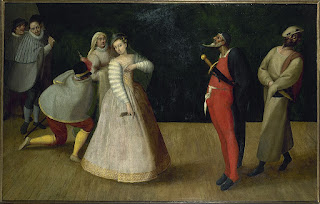Influential figure in growth of commedia dell’arte
 |
| A 16th century painting thought to show Flavio Scala's commedia dell'arte company, I Gelosi |
Commonly known by his stage name Flavio, Scala was the author of the first published collection of scenarios - sketches - from the commedia dell’arte genre.
These scenarios, brought together under the title Il Teatro delle Favole Rappresentative, were short comic plays said to have provided inspiration to playwrights such William Shakespeare and Molière.
They were unusual because the theatre companies were so worried about rival troupes stealing their ideas that publishing them was considered too risky.
Commedia dell’arte was a theatrical form that used improvised dialogue and a cast of masked, colourful stock characters such as Arlecchino, Colombina and Pulcinella. The characters tended to be exaggerated versions of social stereotypes. Figures of authority, such as doctors or city officials, were often portrayed as buffoons, while the servants were much more lovable and sympathetic.
 |
| The cover page of Scala's collection of scenarios, published in 1611 |
Innamorati - lovers - were staple characters in commedia dell’arte, generally seen to be in love with themselves as much as other members of the cast. They were central to the plots of most scenarios.
As well as I Gelosi, Scala worked with a number of other successful commedia dell’arte companies. He can also be said to have been theatre’s first professional producer, having identified and hired an actor to play opposite him as his innamorata. She was Isabella Andreini, the 16-year-old wife of another actor, Francesco Andreini, who was such a success in the role that the company’s stock female lover became known as the Isabella.
Scala’s writing and directing reinforced commedia dell’arte as a highly expressive and physical art form, underlining the importance of body and facial gestures. The 50 scenarios in his collection Il Teatro delle Favole Rappresentative, published in 1611 and sometimes known simply as the Scala collection, did not contain any dialogue.
They consisted instead of detailed stage direction, descriptions of the actions the characters were required to perform. Dialogue in commedia dell’arte was improvised, the most successful actors those who could reference topical events or popular culture.
The collection was republished a number of times and, in 1967, appeared in translation for the first time as Scenarios of the Commedia dell'Arte. More recently, translation of 30 of the scenarios was published as The Commedia dell'Arte of Flaminio Scala: A Translation and Analysis of 30 Scenarios, by Richard Andrews.
Little is known about Scala’s private life, although it is thought he was born into an aristocratic family and fathered one child, Orsola, who herself became an actress. His death was recorded as having occurred in Mantua in 1624.
_-_2021-08-28_-_2.jpg) |
| The facade of the church of San Luigi dei Francesi in Rome |
Flaminio Scala’s life coincided with that of the temperamental but brilliant painter, Caravaggio, who was active largely in Rome and was a major influence on the art of the Baroque period. Rome today hosts approximately 25 Caravaggio masterpieces, several of which are on free public display in churches, including the basilicas of Sant’Agostino and Santa Maria del Popolo, which has two of his masterpieces in the Cerasi Chapel, and the church of San Luigi dei Francesi, where three Caravaggio paintings can be viewed in the Contarelli Chapel. The Sant’Agostino basilica is in Campo Marzio, where in 1606 the painter killed a man in a row over a woman, after which he spent the rest of his life effectively on the run.
 |
| Mantua, like Venice, gives the impression of rising from the water, in this case the Lago Superiore |
Mantua, where Flaminio Scala died, is a Renaissance city surrounded on three sides by lakes, which can create the impression that the city rises from the water in the same way that Venice seems to emerge from the lagoon. It is a city with a rich artistic and cultural heritage, going back to the time of Virgil, the Roman poet, said to have been born in a village nearby. In the Renaissance, Frederico Gonzaga II and Isabella d’Este presided over one of the finest artistic courts in Europe, to which they invited many musicians, artists and writers, among them Leonardo di Vinci and Raphael. Claudio Monteverdi’s opera L’Orfeo was performed for the first time in Mantua in 1607. More than 200 years later, Giuseppe Verdi set his opera, Rigoletto, in the city.
Also on this day:
1389: The official ‘birthday’ of Cosimo de’ Medici, banker and politician
1871: The birth of Nobel prize winner Grazia Deledda
1966: The birth of rapper and musician Jovanotti
1979: The death on Capri of English actress and singer Gracie Fields
No comments:
Post a Comment